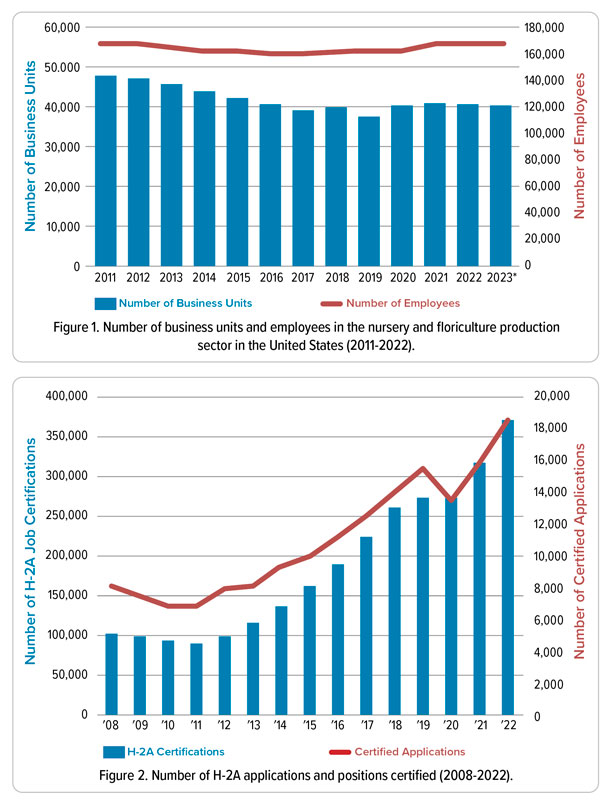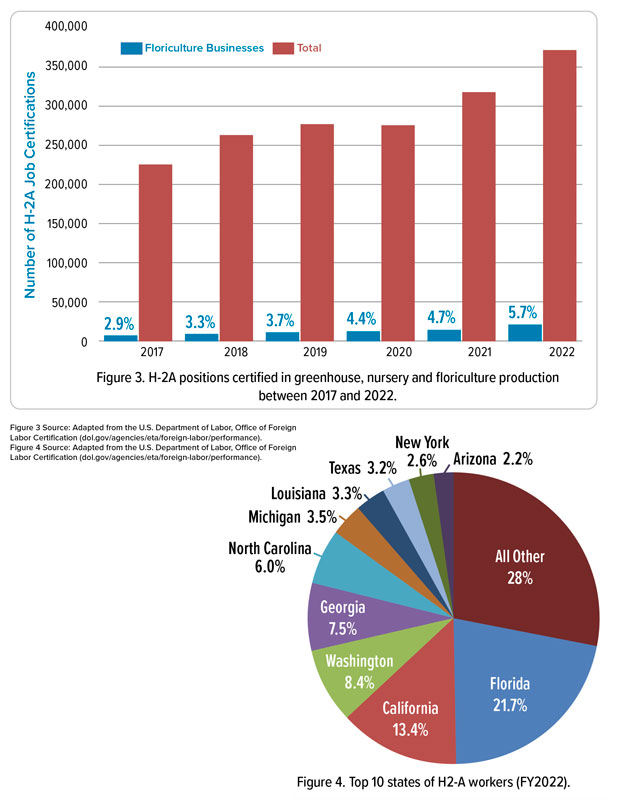12/1/2023
Help Wanted
Xuan Wei, Benjamin L. Campbell, Hayk Khachatryan & Robin G. Brumfield

The agricultural industry in the United States has a long history of relying on immigrant farm labor, particularly in the specialty crop sector where labor-intensive tasks like harvesting are common.
According to a recent report by Hernandez and Gabbard (2018), a significant majority (75%) of farmworkers are foreign-born, with 69% coming from Mexico. Nearly half (49%) of all farmworkers are unauthorized. Most farmworkers were employed in labor-intensive production: 37% in vegetables, 32% in fruit and nut crops, and 19% in ornamental horticulture.
The reliance on immigrant labor is evident in the nursery and floriculture production sector, which has experienced significant economic growth in recent years, with the total economic contributions reaching $28.69 billion in 2018 (Hall et al. 2020). As of 2022, IBISWorld Industry Report estimated that the sector has more than 40,500 business units and supports more than 165,000 jobs (Figure 1).
The horticulture industry relies on workers to engage in myriad tasks, such as pruning, applying fertilizers, scouting, spraying pesticides, planting, harvesting, packing and weeding. Because of the perishable nature of horticultural goods, a skilled and accessible labor supply is imperative for continued industry growth and stability. However, in recent years, the agricultural industry has seen a decline in the number of immigrant workers. This can be attributed to several factors, including a slowdown in migration from Mexico to the United States and changes in the farm labor workforce. As farmworkers age and become more settled, they travel less frequently between farms for work. Additionally, more job opportunities are available in non-agricultural sectors, which may be drawing workers away from farm work. Finally, stringent border control and local immigration enforcement measures may also be contributing to the reduction in the supply of farm workers.
As labor shortages in the agricultural industry persist, more and more growers are turning to the H-2A program as a source of farm workers. A grower must submit a request to the U.S. Department of Labor (DOL) to certify that there aren’t enough U.S. workers available to perform the temporary agricultural job, and that the employment of foreign workers will not adversely affect the wages and working conditions of similarly employed U.S. workers. Once the DOL certifies the employer's request, the employer can proceed with the application process with U.S. Citizenship and Immigration Services (USCIS) to petition for foreign workers to enter the U.S. under the H-2A program.
According to the DOL Office of Foreign Labor Certification, between 2008 and 2022, H-2A agricultural guestworker applications increased by more than 240%, while the number of H-2A job certifications rose by 360% (Figure 2). In 2022 alone, greenhouse and nursery production growers secured 20,966 of the 370,907 certified H-2A jobs, accounting for 6% of all certified H-2A jobs (Figure 3).
The top 10 states that hired H-2A workers in 2022 were Florida, California, Washington, Georgia, North Carolina, Louisiana, Texas, New York and Arizona. Together, these states accounted for more than 70% of H-2A workers nationwide (Figure 4).
 While California has historically had low utilization of the H-2A program due to regulatory bottlenecks and associated costs, the state’s use of the program increased significantly in recent years. Meanwhile, the rising Adverse Effect Wage Rate (AEWR) in recent years in many states has made H-2A labor more expensive per hour. These trends are noteworthy and may have important implications for the agriculture industry in California, as well as other regions of the country. It will be important for stakeholders to continue monitoring the situation and adapting their strategies accordingly.
While California has historically had low utilization of the H-2A program due to regulatory bottlenecks and associated costs, the state’s use of the program increased significantly in recent years. Meanwhile, the rising Adverse Effect Wage Rate (AEWR) in recent years in many states has made H-2A labor more expensive per hour. These trends are noteworthy and may have important implications for the agriculture industry in California, as well as other regions of the country. It will be important for stakeholders to continue monitoring the situation and adapting their strategies accordingly.
Our study based on the 2014 and 2019 National Green Industry Surveys sheds light on the decision-making processes of ornamental growers when it comes to hiring H-2A workers. Growers’ decisions are primarily influenced by two factors: their home states’ enforcement of the 287(g) program, and the industry's employment and wage payment trends. Growers are more likely to participate in the H-2A program if their home states have implemented the restrictive 287(g) program. However, an increase in domestic workers’ industry employment will likely discourage participation in the H-2A program, while rising industry wage costs may encourage participation.
In terms of green industry firm characteristics, the study found that an increase of $1 million in farm sales value only marginally increases the probability of program participation. This suggests that the current H-2A program may pose a hurdle for small growers, but benefit larger growers.
These findings underscore the need for growers to stay informed about the changing landscape of labor regulations and policies, particularly as they pertain to the H-2A program. While most U.S. horticultural operations are too small to need hired workers, larger operations have an interest in the changing U.S. immigration policies hindering labor availability. States such as California, Florida, Washington and Georgia that produce mainly specialty crops (ornamental plants, fruits, vegetables, etc.) have shown an increased dependency on the H-2A program. The procedural burden and pre-employment costs (e.g., housing and transportation) of the current H-2A program may have created a hurdle that potentially disincentivized small and medium-sized firms from recruiting H-2A workers. Additionally, the AEWR increase can also make it more challenging for growers to use the H-2A program.
As the availability of farm labor continues to decline, horticultural growers must adapt to this challenge. Given the diversified nature of ornamental plants and common practices of producing a range of crop mixes within the industry, a more viable solution for horticultural growers could be adopting more efficient labor management practices. State nursery and greenhouse growers’ associations can play a vital role in helping employers streamline the hiring process, such as filing for H-2A visas and educating producers on legal and best practices, including compliance with housing and transportation requirements. These services can significantly benefit small and medium-sized growers by overcoming participation hurdles. GT
Xuan Wei and Hayk Khachatryan are in the Food & Resource Economics Department, and Mid-Florida Research & Education Center at the University of Florida. Benjamin L. Campbell is in the Department of Agricultural & Applied Economics at the University of Georgia. Robin G. Brumfield is in the Department of Agricultural, Food & Resource Economics at Rutgers, The State University of New Jersey.